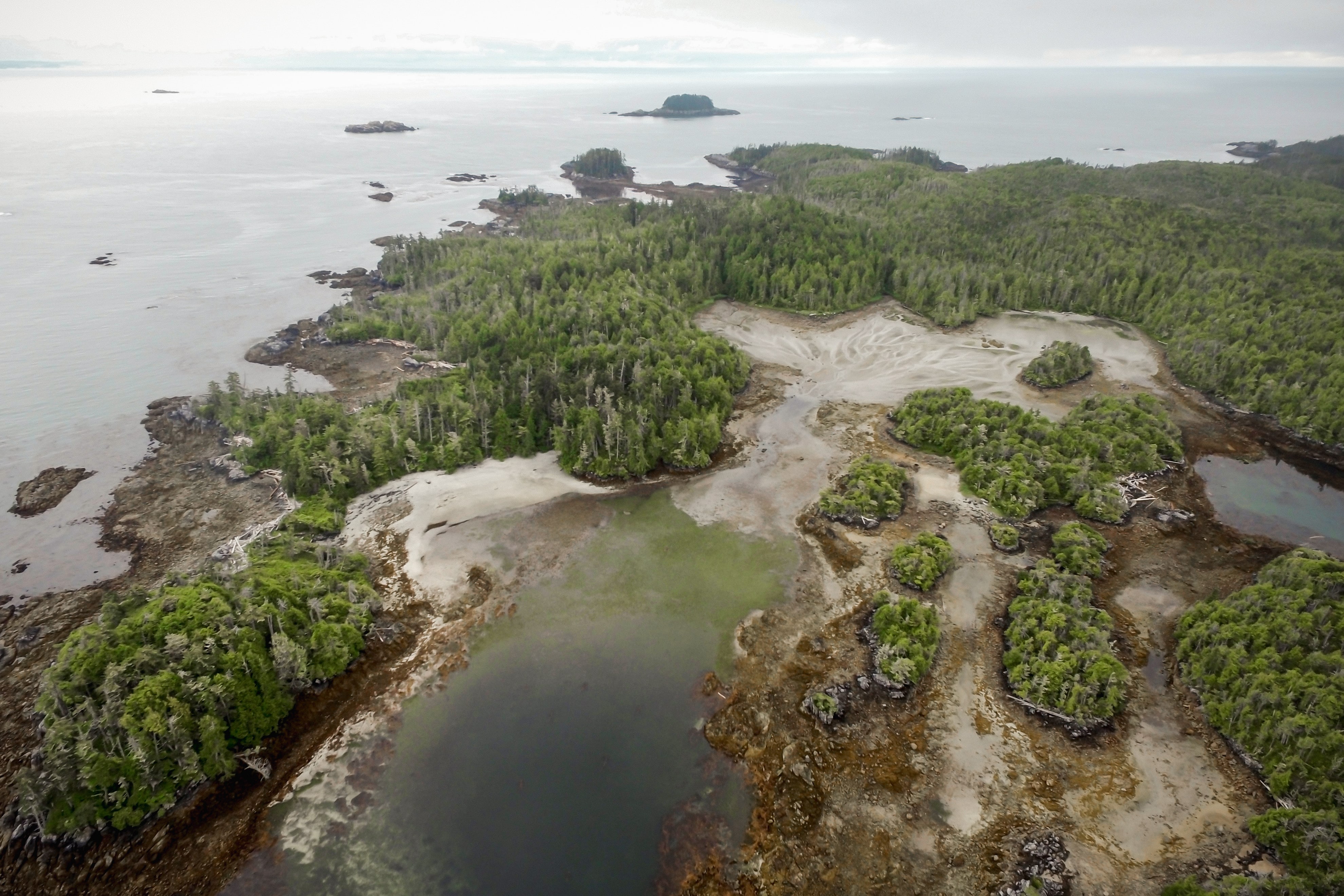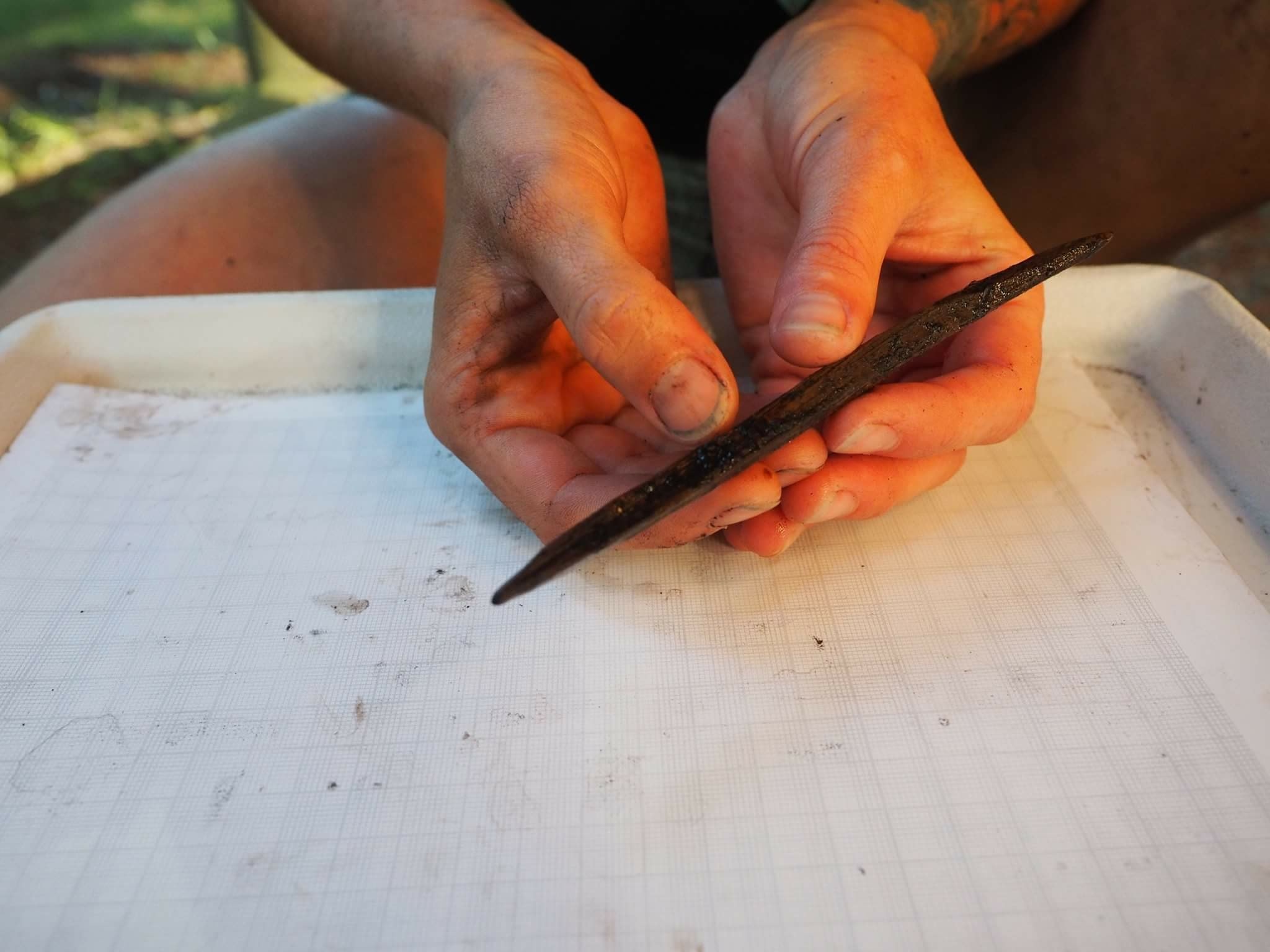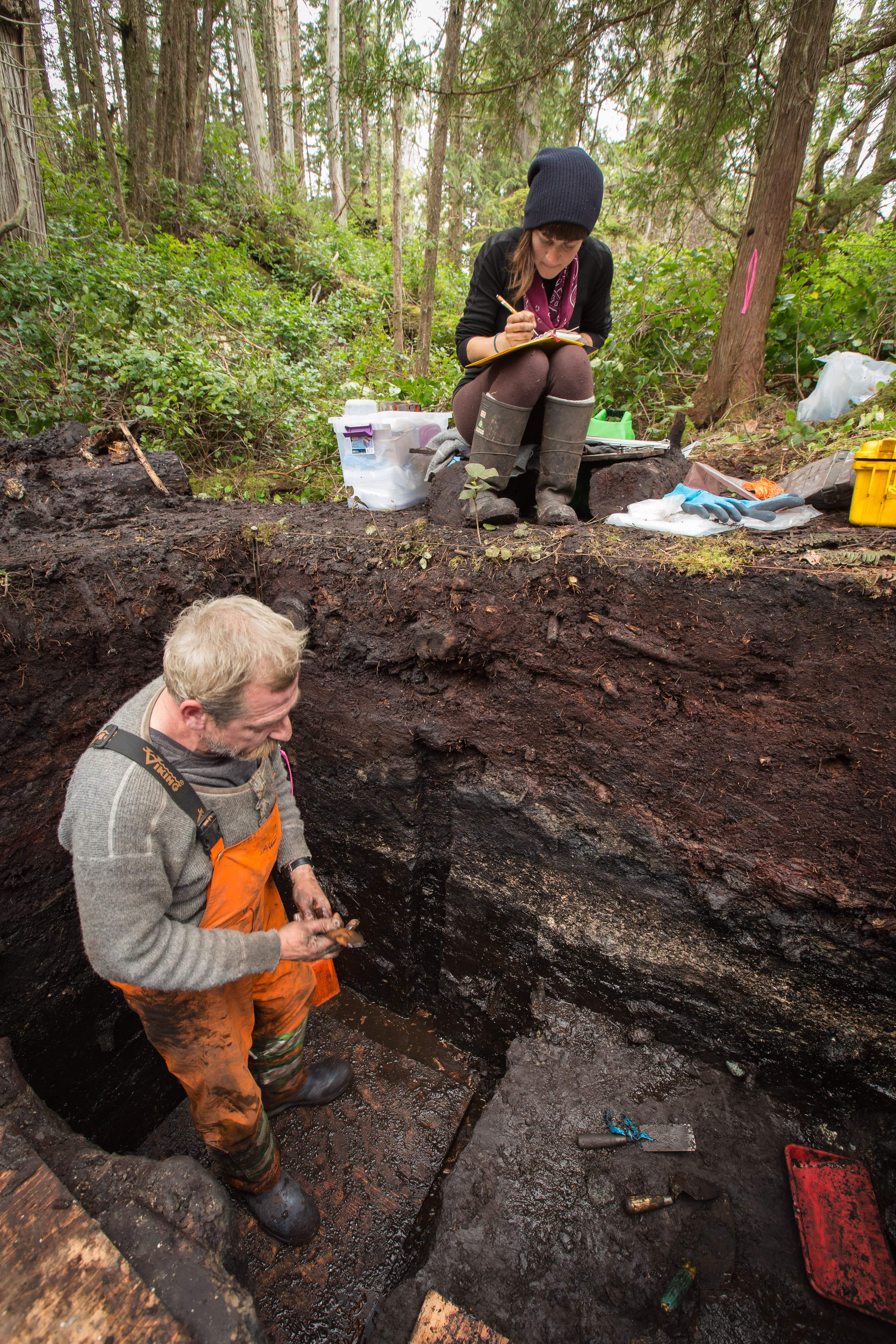A 14,000 Year-Old Discovery Emerges From Oral History
11:38 minutes

The Heiltsuk people of Canada report in their oral history that an island on the west coast of their territory has been home to the Heiltsuk for thousands of years—one of the only places to stay uncovered during the ice age.

When archaeologists digging on Triquet Island last year found charcoal flakes that could be dated at up to 14,000 years old, the Heiltsuk found their oral history reaffirmed by the data. And archaeologists had more evidence to an emerging hypothesis: that, after crossing the Bering Sea, the original inhabitants of North America traveled along the coast to avoid the inhospitable ice cover.
[How to throw a party in Ancient Peru.]
Alisha Gauvreau, a research fellow at the Hakai Institute and a Ph.D. student at the University of Victoria, shares the significance of the find. Plus, we hear from Heiltsuk Nation member William Housty about how Indigenous groups can use archaeological findings to support their claims to land in treaty negotiations with governments.

Alisha Gauvreau is a scholar at the Hakai Institute and a PhD candidate at the University of Victoria in Victoria, British Columbia, Canada.
William Housty is on the board of directors for the Heiltsuk Integrated Resource Management Department in Bella Bella, British Columbia, Canada.
IRA FLATOW: This is Science Friday. I’m Ira Flatow.
Late last year, archaeologists digging up an ancient village belonging to the Heiltsuk First Nation in British Columbia painstakingly excavated a few flakes of charcoal from what once had been a hearth. They sent the charcoal out for an analysis that would reveal its age. And the number they got back shocked them.
That village, abandoned since a smallpox epidemic in the late 1800s, isn’t just old. It turns out that it’s as much as 14,000 years old. That’s three times as old as the Pyramids at Giza. And while that number doesn’t make it the absolute oldest in North America, it does make it one of the older sites.
And it adds more fodder for a question that archaeologists and anthropologists have been puzzling over for many years. The first people to arrive in North America, did they travel inland, through a corridor of land freed from the Ice Age glaciers? Or did they cross the Bering Strait and follow the shoreline in boats to find more welcoming places to settle? What’s called the kelp highway hypothesis.
Also pondering those questions is my guest, who’s been working on this site at Triquet. Alicia Gauvreau, a scholar with the Hakai Institute and PhD candidate, University of Victoria in British Columbia. Welcome to Science Friday.
ALICIA GAUVREAU: Hello.
IRA FLATOW: So this site is three times as old as the pyramids? What’s that in the context of habitation of North America?
ALICIA GAUVREAU: Well, as you said just a moment ago, there are several sites that date to around the same time as the very early date that we obtained for Triquet Island. So what this is suggesting is that people have been here for tens of thousands of years. What’s so exciting about that for the general public is that, well, in particular, in terms of celebrating Canada’s history of 150 years, it puts into perspective how long people have actually been here.
IRA FLATOW: Well, the island has been constantly occupied, even when the rest of Canada was covered in ice. How did that happen?
ALICIA GAUVREAU: That’s quite right. So this occurred as a result of what we are calling a sea level hinge. And this was identified by Duncan McLaren and crew a few years ago through modeling and coring of the Hakai region. And so due to the sea level hinge, the sea level remained relatively stable in this area for that entire time, so since the end of the late Glacial Maximum.
So all the rest of the landmass was covered in ice. As those ice sheets started to recede– and we had some major shifts in sea levels coast wide, so further to the north and to the south in the magnitude of 150 to 200 meters of difference, whereas here it remained exactly the same. So people were able to return to this island repeatedly over time.
IRA FLATOW: The Triquet Island site is in the territory of the Heiltsuk Indigenous group. William Housty is on the board of directors of the Heiltsuk Integrated Resource Management Department. We talked to him by phone earlier this week. And he said the find matches what the Heiltsuk have been saying about their history for thousands of years.
WILLIAM HOUSTY: Our oral history talks about how, in that particular area around Triquet Island, was one of the only areas in our territory that wasn’t covered by the ice during the Ice Age. So the people flocked there for survival, because everywhere else was being covered by ice and all the ocean was freezing and all of the food resources were dwindling.
So in the end, it was the group of people that were able to survive the Ice Age survived right there around Triquet Island. And, now, to have this archaeological evidence saying the same thing is pretty powerful.
IRA FLATOW: And the Heiltsuk pointed you to this dig in the first place?
ALICIA GAUVREAU: We have been working with the community members in the Heiltsuk Integrated Resource Management Department since around 2012. And we confer with them. And we engage in the exchange of knowledge and knowledge building and sharing to help direct us, yes, in terms of which areas are likely to have cultural deposits.
IRA FLATOW: And what kind of artifacts are you finding? What did they say about how the people on Triquet Island lived and who they were?
ALICIA GAUVREAU: So the artifact collection is quite impressive, due to the preservation characteristics of the sediments on Triquet, due to the peat deposits, in particular. And, of course, analyses are ongoing. But some of the neato artifacts, stone tools include utilized obsidian micro-blades and flake tools, a graphite nodule, as well as ground-stone tools.
Wooden artifacts include atlatls and spear throwers, so spear-thrower board, fragments of fishhooks, a hand drill for starting fires, carved wooden bipoints of various lengths, and a very curious faceted wooden ball, as well as a fragment of a carved [INAUDIBLE] stick.
And I could go on, but basically, all of these things, coupled with the fallen assemblage, tell us that the earliest people were making relatively simple stone tools at first, perhaps expediently, due to the parent material that was available at the time. They were also pursuing sea mammals by watercraft. They were gathering shellfish.
And, later, they engaged in trade or traveled great distances to procure specific materials for specialized stone tool production, so those obsidian micro-blades and flakes, as well as greenstone and the graphite. In later times, it seems as though it shifted more towards a focus on rockfish and herring and lingcod.
IRA FLATOW: So these were a seagoing people. And does this add to the kelp theory hypothesis that the early North Americans came over by boat?
ALICIA GAUVREAU: Well, it certainly adds evidence to the fact that people were able to travel by boat in that coastal area by watercraft. Because, as mentioned before, the sea level has been relatively the same. That would have been the only way to get out to Triquet Island. And it also shows how masterful and experienced sea travelers these people would have been in order to get out to this very exposed outer coastal island as well.
IRA FLATOW: Now, the Heiltsuk routinely negotiate with the Canadian government on management of natural resources, governance of their territory, negotiations that rely, in part, on their record of inhabiting that territory over a long period of time. Here’s William Housty again.
WILLIAM HOUSTY: Up until about 30 years ago, all this information was transmitted through speech. There was no record of any of this oral history. So when we’re at the table with our oral history, it’s like me telling you a story. And you have to believe me without seeing any evidence. So you have to trust me that I’m telling you the truth, which isn’t always the easiest thing to do, especially when you’re dealing with government.
So now that we can go to the table with the government in negotiations, we can have not only our oral history but we can also have the archaeological evidence and the data from western science to say what these stories are saying are actually verified, are actually true. They’re actually dovetailing together, telling a really powerful tale. So that’s really going to be very significant, gonna will definitely give us a leg up in negotiations for sure.
IRA FLATOW: And I would imagine, Dr. Gauvreau, that this partnership with the Heiltsuk also benefits archaeologists.
ALICIA GAUVREAU: Oh absolutely, absolutely. In terms of the knowledge sharing and then the insight that we can have in terms of the interpretation of the various natural and cultural deposits that we’re interacting with, for sure.
IRA FLATOW: Do we know that maybe they migrated off the island to other places too?
ALICIA GAUVREAU: Well, there are definitely other sites on the coast, so [? Namoon, ?] nearby, has, I believe, a basal date of about 11,000 years before present. And then, as well, there is the footprint site that is also being investigated through the Hakai Ancient Landscapes Archeology Project, which has a date of about 13,000 years ago.
So, yes, indeed, there would have been some island hopping in this area. But Triquet Island, unlike those other locations, that very early date that we have is stratagraphically below other deposits that date to around 11,500 all the way up to 5,000 years ago and then continuing on. They were definitely sticking around Triquet Island longer than anywhere else.
IRA FLATOW: That’s amazing. OK, let’s talk about the next questions to answer about this site and about early North American people as a whole. What would you like to know, and how would you like to find it? If you had a blank check, and you could spend any amount of money that you can, what would you like to do with it?
ALICIA GAUVREAU: Oh my goodness, well, I’d like to do environmental DNA analysis at the site, because you are able to pick up traces of species. So in terms of more in-depth faunal analysis as well, because you’re not just looking for the bones but also those chemical signatures in the soil showing what is actually in those sediments.
In addition to that, oh goodness, what were those impacts of the tsunami events on the people living there? And how can we come to evaluate that? What does this historical ecology of the island tell us about climate and subsistence cycles more broadly? As well as what this data can tell us about– to inform stewardship policies and resource management more broadly as well as specific to that region.
I’m also really interested in using the data from Triquet Island to better understand these existing theories of change and, more importantly, continuity. So, again, why are people returning to this place over and over again and staying there for prolonged periods of time? And, of course, the Heiltsuk have spoken about that. And William has shared a bit about why it’s such an important area as well.
IRA FLATOW: Did the Heiltsuks survive continuously? Do you have data for that? Or would the DNA tell you that if you could use it?
ALICIA GAUVREAU: The environmental DNA would tell us about the subsistence use, surely, and then the environment more broadly. We haven’t done any genetic testing with the community. That is in ongoing discussion. Of course, there are other studies that have been done coast wide that have investigated that sort of thing. But, yes, not at this point in time.
IRA FLATOW: Are you having any luck raising the money to do these things that you would like to do?
ALICIA GAUVREAU: Well, all of our work is currently supported by the Hakai Institute and Tula Foundation. And this project has been ongoing for about five years. And they also provide the infrastructure and other support through the Hakai staff.
And, indeed, we are very open to collaborating with other researchers and outsourcing some of the analyzes where appropriate. I’ve also applied for a shirt grant. So waiting to hear back about that as well.
IRA FLATOW: Well, we wish you luck. It’s quite an interesting find. And thank you for sharing everything you’ve learned on it.
ALICIA GAUVREAU: Thanks so much, Ira. It’s very exciting.
IRA FLATOW: Alicia Gauvreau, a scholar with the Hakai Institute and a PhD candidate at the University of Victoria in British Columbia. I think she’s going to get that PhD after this one.
Copyright © 2017 Science Friday Initiative. All rights reserved. Science Friday transcripts are produced on a tight deadline by 3Play Media. Fidelity to the original aired/published audio or video file might vary, and text might be updated or amended in the future. For the authoritative record of ScienceFriday’s programming, please visit the original aired/published recording. For terms of use and more information, visit our policies pages at http://www.sciencefriday.com/about/policies/
Christie Taylor was a producer for Science Friday. Her days involved diligent research, too many phone calls for an introvert, and asking scientists if they have any audio of that narwhal heartbeat.